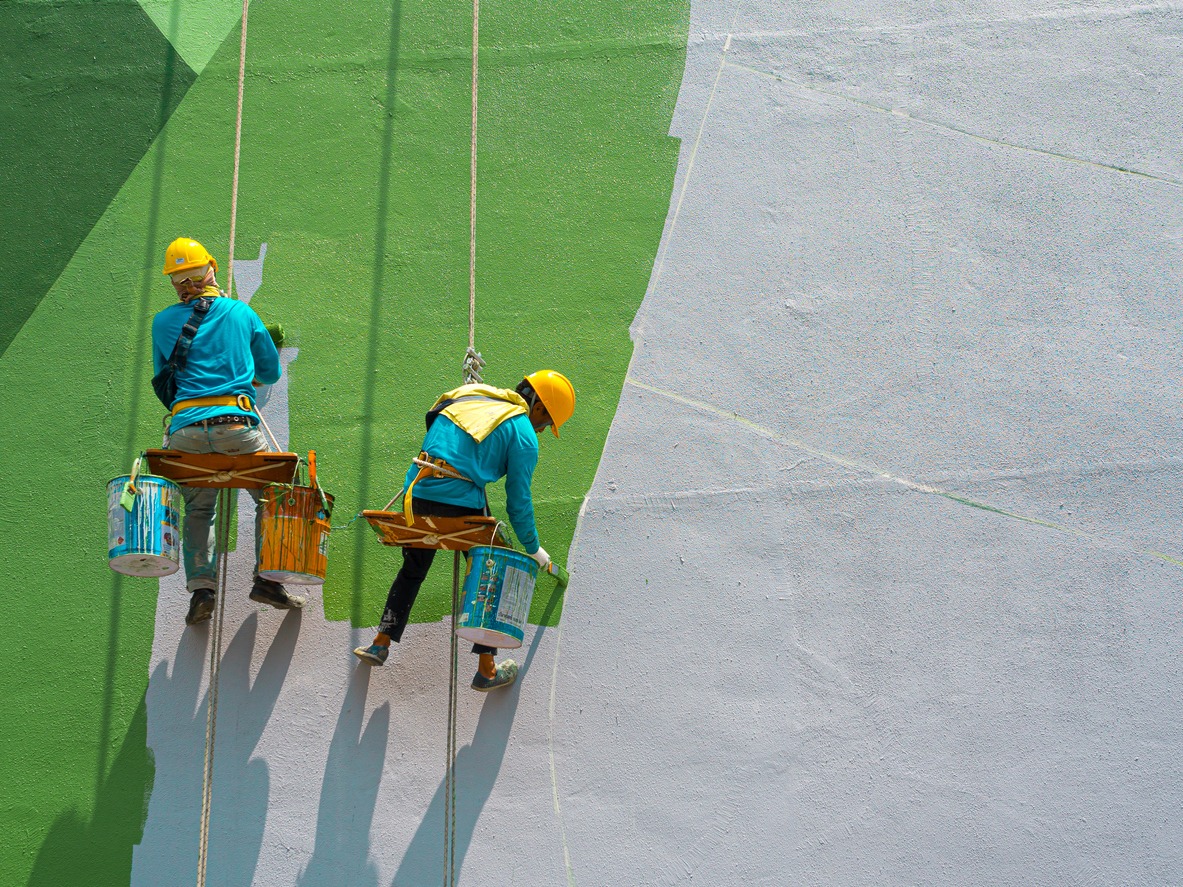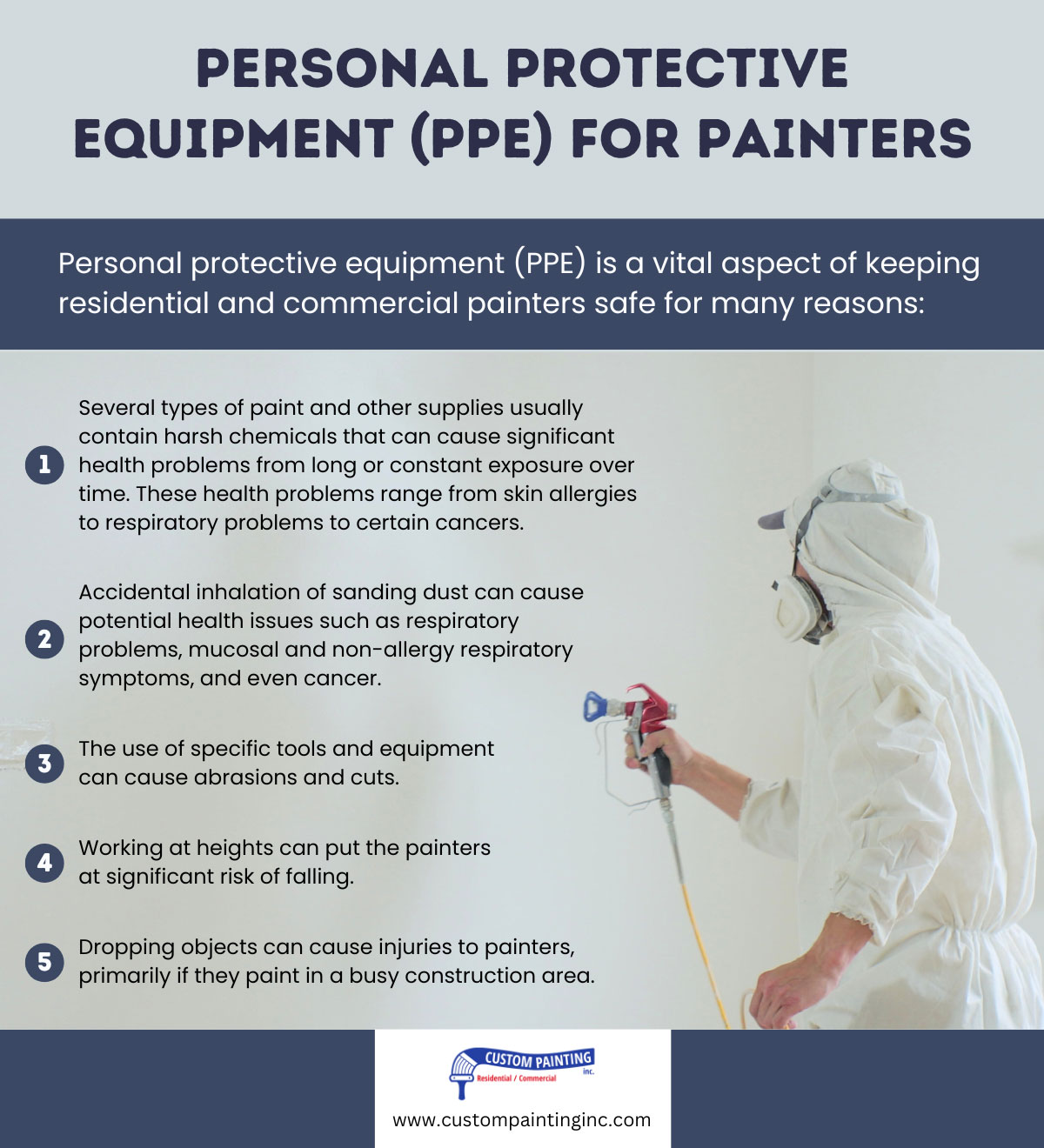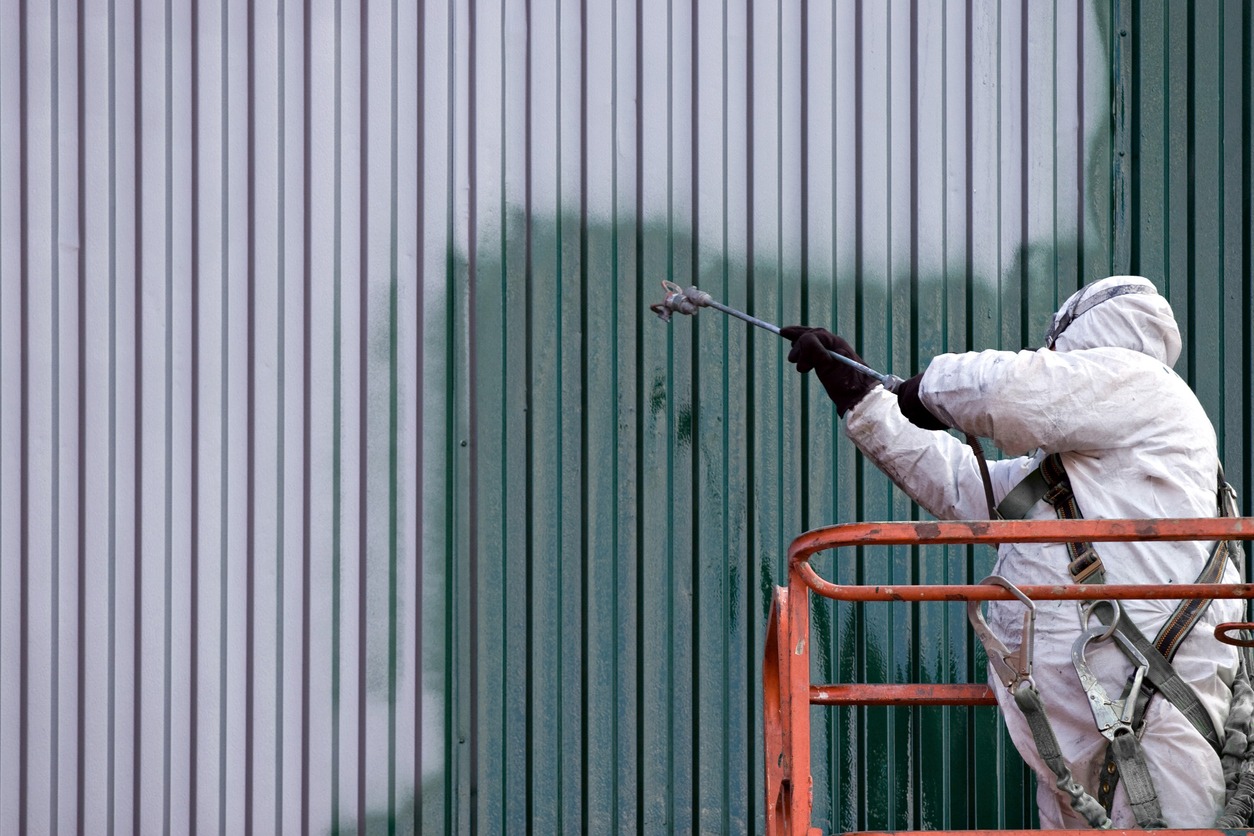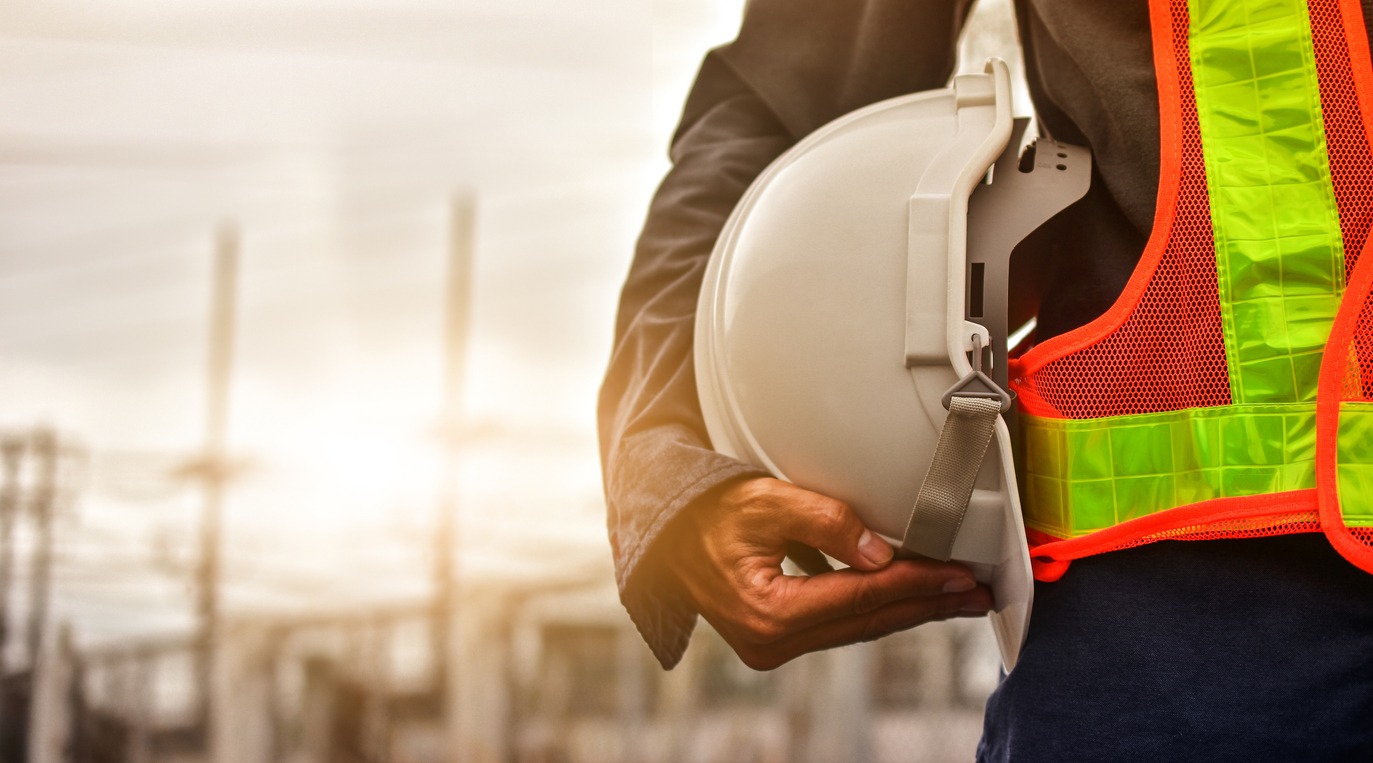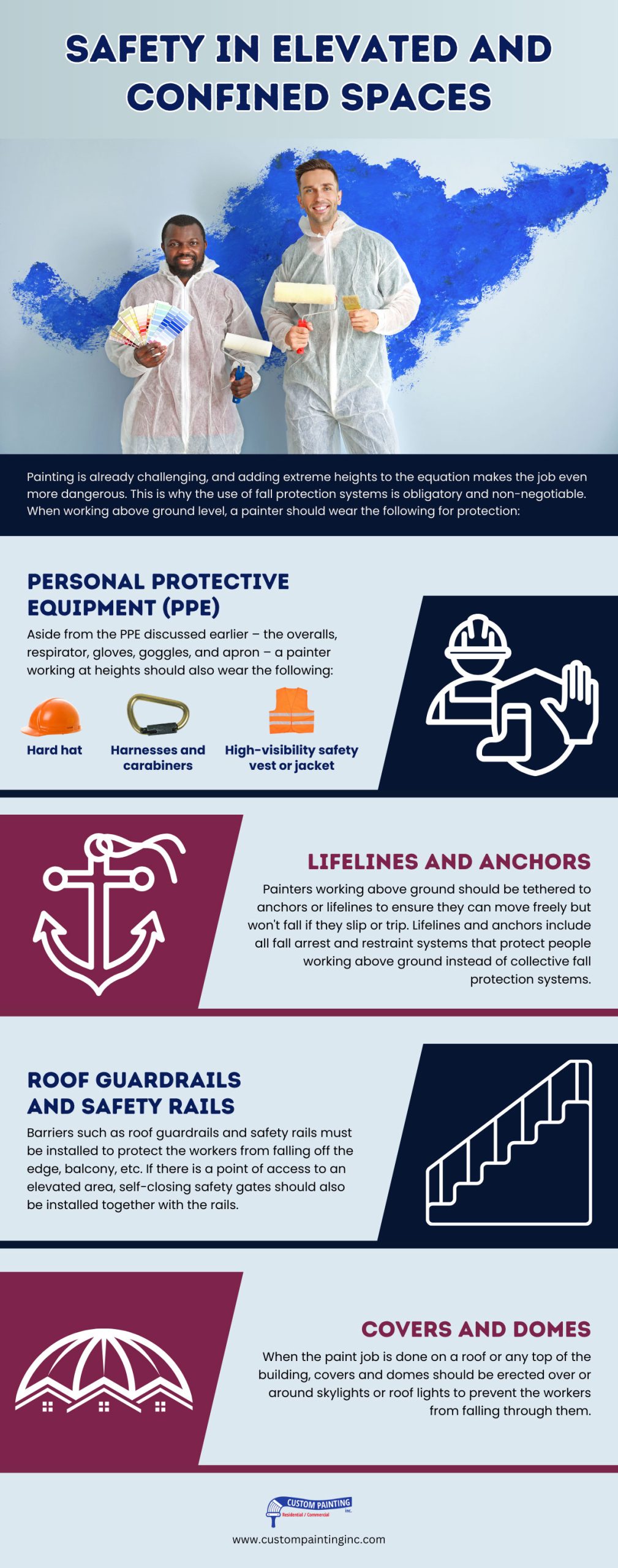Regardless of the industry you’re in, including painting in San Ramon, CA, workplace safety is of paramount importance. The primary goal of a safety program in any workplace is to reduce the risks of illness, injury, or fatality to workers. In addition, a safe work environment can lead to less stress and anxiety and better mental health and overall well-being for the workers.
Adhering to industry safety standards should benefit many businesses, including preventing potential lawsuits and paying legal fees. It will lead to optimal performance from the staff, higher productivity, and overall job satisfaction.
In residential and commercial painting, the paint crew is exposed to several potential accidents and hazards, from falling from a height to inhaling toxic paint fumes. Exposure to these hazards may lead to infections, injuries, illnesses, and death. Professional painting is indeed a high-risk job, so employers ensure that the paint crew is adequately protected and follows safety practices to keep them from any potential harm.
But it’s not just the workers that employers should protect. Painters must also be insured to protect themselves and their clients from injuries and illnesses.
Any responsible paint service company should always be conscientious enough to use the proper safety gear and follow the industry safety guidelines at the work site. This article aims to provide a comprehensive guide to safe painting practices.
Understanding painting hazards
Painting residential and commercial buildings can expose workers to several hazards, which include:
- Prolonged standing
- Working at heights
- Slips and falls
- Falling from ladders, scaffolding, lifts,
- and other high places
- Exposure to chemicals and sanding dust
- Working in confined spaces
- Improper ventilation
- Exposure to heat and cold
- Dropped objects
- Lifting heavy or awkward objects
- Repetitive strain injury
- Electrical hazards
- Injury from specific tools and equipment
- Noise
If the painters neglect safety measures or the employers fail to give them protection and safety training, they will end up with the following adverse consequences:
- It will increase the risk of infection, illness, injury, or death.
- If the employees feel that they’re not protected and feel unsafe at work, their morale and productivity will suffer.
- The resulting sickness and injury can put the employee out of work and impact his quality of life.
- Work-related deaths and injuries can do irreversible damage to the company’s reputation.
- The workers can file a lawsuit against the company, leading the employers to pay fines, legal fees to attorneys, and compensation to the aggrieved workers. It can even put the employers behind bars.
If the workers feel unsafe at work and need the proper safety training and equipment, how do you expect them to want to work hard for you as an employer?
Whether doing residential, commercial, or industrial painting, the crew has the right to feel safe while on the job. Here are some of the following critical areas of painting where safety is crucial:
- Proper ventilation is critical, especially if you have to use solvent-based paints. Ensure that ventilation is sufficient to allow the paint fumes to dissipate. If you’re painting in a confined area, open the door and windows and turn on fans to let the paint fumes out and the fresh air in.
- Not only are paints, stains, and stripper fumes harmful to inhale, but they can also be highly flammable. To prevent the possibility of a fire incident, remove any ignition sources (open flame, welding, lights, smoking, etc.) until the fumes dissipate.
- Invest in personal protective equipment PPE such as overalls, gloves, eye protection, hard hats, respirators, etc.
- When painting above ground – whether on a high ceiling or up a multi-story building – painters should be tethered to harnesses, anchors, and lifelines to ensure they won’t fall if they slip or trip.
- Before painting above ground, check your ladder, scaffolding, or mechanical lift for defects.
Safe preparation before painting
- Assessing the work environment for potential hazards. For example, if the building you’re evaluating is of considerable age, its current paint may contain lead, which is toxic. If the building is tested and confirmed to have lead-based paints, it requires the proper and safe removal and disposal of such paints before a new painting job begins.
- Proper planning and setting up a protected workspace are vital for a safe paint job. It would be best to keep the area well-ventilated by opening doors and windows and turning on exhaust fans. Remove all furniture and decor to allow more elbow room for the paint crew. Turn off the main power before covering all exposed electrical outlets with painter’s tape. Use the safest possible paint products, preferably the ones with a low or zero VOC content.
- In addition to selecting the safest possible paints and other coatings, the right tools and equipment with the right features are also essential for a safe and successful paint job. Make sure that you invest in the right tools to help you deliver a smooth and secure paint job.
Personal protective equipment (PPE) for painters
Personal protective equipment (PPE) is a vital aspect of keeping residential and commercial painters safe for many reasons:
- Several types of paint and other supplies usually contain harsh chemicals that can cause significant health problems from long or constant exposure over time. These health problems range from skin allergies to respiratory problems to certain cancers.
- Accidental inhalation of sanding dust can cause potential health issues such as respiratory problems, mucosal and non-allergy respiratory symptoms, and even cancer.
- The use of specific tools and equipment can cause abrasions and cuts.
- Working at heights can put the painters at significant risk of falling.
- Dropping objects can cause injuries to painters, primarily if they paint in a busy construction area.
Therefore, the PPE protects the crew working with paint, primers, varnishes, thinners, wood stains, and other things they may usually deal with, like cleaning products and sanding dust.
The PPEs consist of suits and other wearable safety items designed to resist chemicals and dust. Professional painters wear PPEs to protect them from the harmful effects of paint, other products (such as cleaning), and sanding dust. These suits cover the entire body and include the following:
- Overalls – Overalls have long sleeves and legs to protect the arms and legs from paint drips and sanding dust. Overalls should also have a hood to protect the head from paint drips and splatters.
- Respirator – A painting respirator is worn over the mouth and nose to keep the harmful paint fumes and sanding dust out of the wearer’s breathing zone. The respirator should fit tightly around the wearer’s face so that there’s no chance for the vapors and dust to get through the gaps in the mask.
- Safety goggles – A pair of goggles will sufficiently protect the wearer’s eye from splatters, vapors from chemicals, and sanding dust while painting. Some goggles come with tinted lenses to help block the sun’s ultraviolet rays or glare when working indoors under a bright light.
- Gloves – Good gloves should be worn on both hands to protect them from paints, abrasions, and cuts. They should snugly fit around the fingers, palms, wrists, and knuckles so that nothing gets into them. Some gloves are disposable, while others are reusable and can be washed properly.
- Apron – An apron can help protect the wearer from drips and splatters, splashes, spills, and smudges by protecting the clothes underneath during painting.
- Shoe covers – Disposable shoe covers should protect the wearer’s footwear and any exposed skin that could become irritated by contact with paint, sanding dust, cleaning chemicals, thinners, etc.
If the project requires spray painting, the paint crew should wear the following recommended PPEs:
- Eye protection that conforms to American National Standards Institute (ANSI) guidelines, including a shield or a pair of goggles (if necessary).
- Respiratory protection conforms to the National Institute for Occupational Safety and Health (NIOSH) and Occupational Safety and Health Administration (OSHA) standards, including the N95 filtering face-piece respirator.
- Protective clothing that includes coveralls, long-sleeved shirts, rubber gloves, and footwear).
Care and maintenance of PPE is required to keep them in good working condition and continue providing safety for the workers.
- Inspect PPE before and after each use.
- Always take care of PPE.
- Clean PPE after use.
- If the PPE is disposable (such as gloves and shoe covers), discard them immediately after use (and don’t try to reuse them).
- Repair or replace damaged PPE.
- Store PPE in a clean, dry place, free from sunlight, moisture, and contaminants.
Safe handling of paint and chemicals
The chemicals in paint, wood stains, and other products can cause short- and long-term health effects. Inhaling paint fumes may cause some people to experience headaches, dizziness, nausea, eye irritation, and breathing problems.
Commercial and residential painters, naturally, deal with paints, thinners, primers, strippers, wood stains, and cleaning products every day. Frequent or prolonged exposure can cause them to suffer from long-term illnesses – such as respiratory problems, impaired kidneys, and certain cancers – if they are not adequately protected and don’t follow proper safety procedures.
That’s why safe handling of paints and chemicals is a must to protect the painters from bodily harm.
If you paint indoors, keep the area well-ventilated by opening doors and windows and running exhaust fans to promote proper airflow. And, of course, wear PPE when painting.
Instead of using traditional latex or oil paints, use low-VOC or zero-VOC formulas.
After use, clean up and dispose of leftover paints properly. But if you don’t want to throw these paints away, store them in a cool, dry place and out of direct sunlight. Make sure the paints are out of reach of pets and children and away from food, drink, and sources of fire. Store leftover latex paints in lined metal cans to prevent rust. Or you can store leftover paints in glass or plastic containers.
Ladder and scaffolding safety
Many paint projects require painters to work at heights, so ladder and scaffolding safety is crucial to prevent fall-related injuries and fatalities.
The following are some general safety tips to help you use ladders and scaffolds safely when painting a house or commercial building:
- Regularly inspect ladders and scaffolds for cracks or broken joints before using them.
- Place ladders or install scaffolds on stable, flat, and even surfaces. Do not mount a ladder on top of another object.
- Always face the ladder when climbing or descending.
- When using the ladder, keep both feet on it. Do not put one foot on a rung and the other on a different surface.
- Make sure that supported scaffolds have proper access, completely planked platforms, complete guardrails, and appropriate ties to buildings, where required.
- It is best to leave a scaffold’s wood planks unpainted so any cracks or holes will be visible.
- Place scaffolds at least 10 feet from power lines unless you are sure the power lines are de-energized.
- Do not work on a ladder or scaffold in high winds or during a storm whenever possible.
- Protect workers below the scaffold. A toe board should be installed below the scaffold to prevent objects from falling off it. If objects on a scaffold are taller than the toe board, debris nets should be installed to catch falling materials. People should be forbidden from walking under or near the scaffold.
The employer should provide training for any worker who assembles, disassembles, moves, operates, repairs, inspects, or maintains scaffolds.
Ergonomics in painting
Ergonomics is designing a job to fit a worker to make work safer and more efficient. In any workplace, implementing ergonomic solutions is essential to make workers more comfortable and increase productivity.
Workers come in different shapes and sizes. Ergonomics can help minimize pain and possible injuries, making work more comfortable for every individual worker.
Painting a home or building requires physical effort. Painters perform various tasks – painting with brushes or rollers, sanding, mixing paint, climbing up and descending from a ladder, and much more. Many of these tasks have awkward postures, repeated movements, forceful extensions, and sometimes exposure to heat and cold – all contributing factors to developing physical discomfort and pain such as musculoskeletal disorders (MSDs).
Painters should consider the following tips to minimize such physical strain at work:
- Recognize the early signs of musculoskeletal disorders such as aches, pains, weakness, numbness, and loss of strength. It will enable you to take preventative measures (such as doing stretches, changing your posture or position, consulting a physician, etc.) to prevent MSDs from developing.
- Avoid bending at the waist for prolonged periods, especially when lifting or lowering objects. Leaning forward for lengthy periods is a considerable risk factor for back injuries because doing so will strain the spine and surrounding soft tissues. Here are some tips to reduce such strain:
- When possible, raise your work on a bench or two sawhorses.
- Sit on a stool if you must work on lower levels for a prolonged period. This will help remove some stress on your back from bending forward and reduce the stress on your knees from squatting.
- Never place or store materials on a ground level. You must have an elevated surface to place your paints and tools, preferably at waist height, so you won’t have to bend forward repeatedly.
- Reduce overhead work when possible. Overhead reaching and lifting can cause the back to arch. Arching too much can place significant stress on the spine’s joints and strain the shoulders and neck.
- If you must work overhead, get as close as possible to your work by standing on a ladder or any other elevated surface.
- Take breaks frequently.
- When painting above the shoulder level, use a ladder or other elevated surface to prevent your back from over-extending.
- When painting overhead, use stable extensions for painting equipment, such as a telescoping pole for paint rollers.
- Place your can or bucket of paint on a table or any other elevated surface at waist height. This will prevent you from having to hold your paint can or bucket while painting.
- Kneel instead of bend. Consider wearing knee pads or pants with built-in knee pads to protect your knees when kneeling.
- Take a break every two hours. Take some stretches, walk around, and change your posture or position.
Safety in elevated and confined spaces
Painting in elevated and confined spaces presents unique challenges for the painters.
Painting is already challenging, and adding extreme heights to the equation makes the job even more dangerous. This is why the use of fall protection systems is obligatory and non-negotiable. When working above ground level, a painter should wear the following for protection:
- Personal protective equipment (PPE) – Aside from the PPEs discussed earlier – the overalls, respirator, gloves, goggles, and apron – a painter working at heights should also wear the following:
- Hard hat – A hard hat protects the wearer’s head in the event of a possible impact caused by a falling object or collision during a fall.
- Harnesses and carabiners – A safety harness refers to a system of restraints that prevents the wearer from harmful or fatal falls. The harness is usually attached to a stable and stationary object (such as a railing) through carabiners, coupling links with a safety closure. These safety gear items ensure the wearer will not hit the ground if he slips and falls.
- High-visibility safety vest or jacket – Painters working at heights should wear a reflective safety vest or jacket for visibility and protection from potential hazards. Wearing safety vests allows the worker to be seen and alert that someone is present, especially in low-visibility situations.
- Lifelines and anchors – Painters working above ground should be tethered to anchors or lifelines to ensure they can move freely but won’t fall if they slip or trip. Lifelines and anchors include all fall arrest and restraint systems that protect people working above ground instead of collective fall protection systems.
- Roof guardrails and safety rails – Barriers such as roof guardrails and safety rails must be installed to protect the workers from falling off the edge, balcony, etc. If there is a point of access to an elevated area, self-closing safety gates should also be installed together with the rails.
- Covers and domes – When the paint job is done on a roof or any top of the building, covers and domes should be erected over or around skylights or roof lights to prevent the workers from falling through them.
One of the challenges of painting in confined spaces is the significant lack of ventilation. Paints, thinners, primers, industrial solvents, and other substances may emit chemical vapors that can reach dangerous levels in such a small space. Here are a few tips to make painting in confined spaces safer:
- Choose a zero-VOC paint. Or better, choose “green paints” — non-toxic and biodegradable paints that use natural compounds and minerals.
- Open the door and windows (if there are any) to allow proper airflow.
- Use a fan to draw the paint fumes away from where you’re painting and toward the door or window.
- Use a respirator designed to lower your risk of inhaling VOCs and a pair of goggles to prevent the paint fumes from getting into your eyes.
Creating a culture of safety
Painters do a variety of tasks – not just painting! And they work in several various environments. These factors may put these painters at significant risk of injuries, illnesses, or even worse. That’s why it’s essential to maintain their safety wherever they work. One of the ways to do that is to undergo safety awareness training, and every responsible employer should provide that to their workers, preferably regularly.
When trained to work safely, painters should be able to anticipate job-related hazards and avoid accidents and injuries from them. Safety awareness training is essential for the paint crew appropriate to their duty, and the training should be directly applicable to their responsibility and day-to-day tasks.
If a company implements safety protocols and procedures in the workplace, it can protect its crew, customers, and brand reputation. Enforcing safety rules and regulations can minimize the risk of on-the-job accidents and injuries, improve workplace morale, and maximize productivity.
For the employees, reporting of hazards should definitely be encouraged. If a worker sees or experiences unsafe conditions, they should report them to the higher-ups or authorities without feelings of fear or retaliation. Companies should promote safety inspections regularly to identify potential hazards. It’s also a good idea for employers to recognize and reward workers or teams for their significant contributions to workplace safety. It is also wise to emphasize safety during company meetings and discussions.
Conclusion
All commercial painters in Dublin desire to work in a safe and protected environment. Health and safety are critical factors in the paint service industry to promote the wellness of employers, employees, and clients.
Safety is one of the most significant issues, and the company’s responsibility is to ensure its employees work in a safe environment. The consequences can be severe and even life-threatening if the company runs an unsafe operation.
Workplace safety is not just a duty required by law but also a moral responsibility. Employees who work within a facility or at a site have families and personal lives outside of their employment. Their health and safety should never be compromised for a paycheck. For that reason alone, putting their safety and well-being at the forefront of any business, including painting in San Ramon, is critical.


